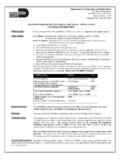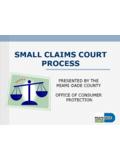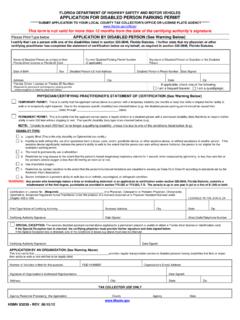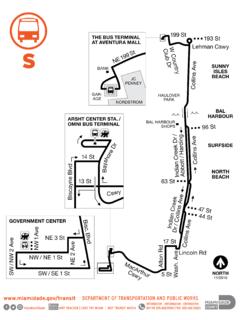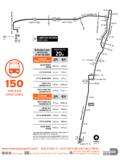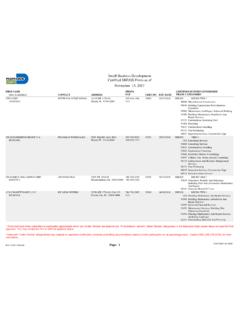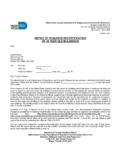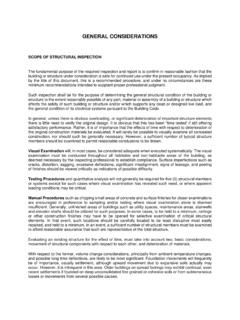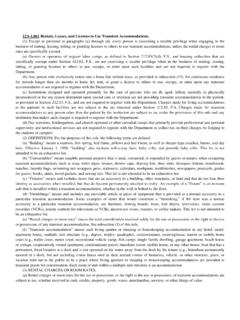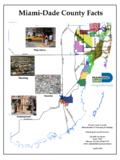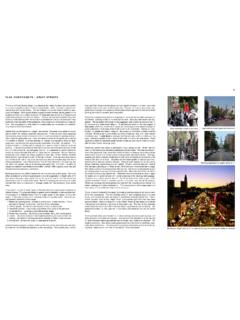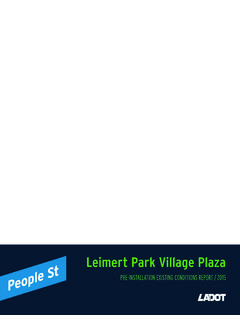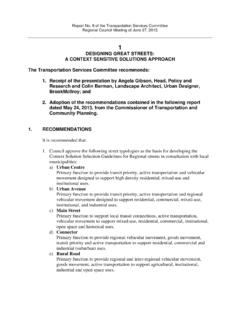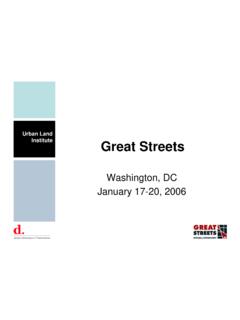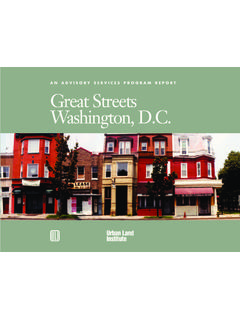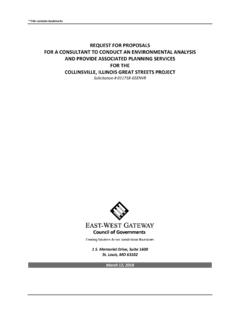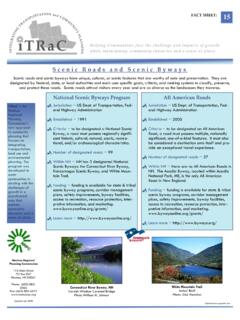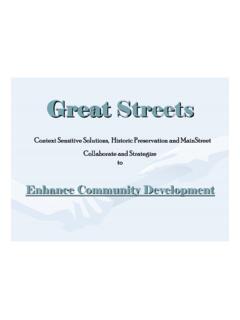Transcription of Great Streets Vision - Miami-Dade
1 45 Great Streets VisionDescription of general area for recreation opportunities not site specifi c46 Comfortable walking room. Before Streets were moving cars, they were moving people. This function continues today, though modern street design has relegated the pedestrian to a smaller portion of the street, if this portion has been retained at all. Pedestrians need ample room to move in groups, to pass one another and to be clear of buildings. Comfort in the walking space also refers to protection from the elements and moving vehicle traffi c. Trees and landscaping not only provide shade for pedestrians, they also buffer pedestrians from moving vehicles and give a sense of comfort in the walking experience.
2 Design elementsSidewalks of a width that responds to expected pedestrian volumes. In neighborhoods, this is likely to be less than immediately around schools, by parks and civic buildings, and, most notably, along commercial defi ned crosswalks that not only provide ample width for pedestrians but that are also visible to motorists. Sometimes, depending on the context of the built environment, these crosswalks can be raised above the surface on speed tables to calm traffi c and further raise motorist awareness to the need for pedestrians to that recognizes pedestrian activity and treats it as movement through street intersections just as vehicles. Pedestrian signals in urban areas should not be activated but should refl ect an understanding that pedestrians should always be given protection of movement when crossing.
3 They should also accommodate sight-impaired pedestrians in giving an audible signal of when it is safe to cross a and landscaping. As implied previously, street trees give pedestrians shade and comfort and buffer them from the moving vehicles of the street. But perhaps more importantly, they reinforce the street s purpose as a public space and resource by enriching aesthetics. They soften what can sometimes be a stark landscape of hard surfaces and buildings and give Streets a connection to passage and accommodation of all moving conveyances. Even aside from the pedestrian, Streets carry more than cars. Well-designed Streets allow bicyclists to feel comfortable close to moving traffi c, whether through the addition of a designated bicycle lane or through other design characteristics that slow vehicle speeds and allow cyclists to safely mix with automobile traffi c.
4 They also support transit use, both in terms of physical dimensions of the traveled way that fi t transit vehicles and through adjacent land uses that allow pedestrian access to elementsBicycle lanes that give the cyclist adequate buffering from moving vehicles and from parked bus lanes when transit use is high enough to justify them or when the nature of transit vehicles (buses for rapid transit, light rail cars) requires a dedication portion of the street for normal operationsDesign Streets that fi t the environment. To be sure, some Streets have the responsibility of carrying heavy vehicle traffi c. Though the rise of automobile-based street design has often emphasized vehicular carrying capacity at the expense of other street elements, Great Streets can certainly be designed to carry large volumes of cars.
5 The key to this is to base the design on the conditions and needs of the built environment: Streets serving urban areas with high pedestrian activity should control vehicle speeds with such elements as trees and smaller cross-section dimensions. Yet in these same environments the primacy of pedestrian access to buildings and destinations means that driveways, left turns into properties and other complications to traffi c fl ow may not be needed as often, allowing high vehicle traffi c loads to move along Streets (even if at slower speeds that improve pedestrian safety conditions).Design elementsMedians not only separate the two directions of travel, they also provide space for additional landscaping (which can aid the street trees on the sides of the traveled way in slowing travel speeds) and potentially a refuge for pedestrians crossing the lanes and a generally tighter street cross section creates a psychological sensation of relative enclosure that encourage motorists to drive more slowly and responsively to their parking to serve the land uses along Streets (especially businesses) and minimize the need for on-site parking in land development, thus improving the effi ciency and return on urban ned edges.
6 Streets are one of the fundamental public spaces in cities and towns and as such need to have clear defi nitions of where their public space ends and adjacent private space begins. In dense urban areas these edges are usually provided by the placement of buildings along the public right-of-way edge, though the edges can still be defi ned by landscaping, yards and the moving vehicle assumed prominence among users of Streets and consequently became the primary driver of decisions on their design, attention to these different elements of the street has declined. The Great Streets Vision is based on an understanding of all of these elements having a place in Miami-Dade s Streets , adding to the sense of place and quality of the built environment and balancing the transportation Streets Design Guidelines47 CIVIC STREETSS treets that provide access to recreational and civic facilities, as well as to pedestrian-oriented shopping and entertainment districts.
7 Examples of Civic Streets in Miami-Dade SW 137th Avenue Miracle Mile Washington Avenue Alton Road Broad CausewaySW 137th Avenue - ExistingSW 137th Avenue - ProposedGATEWAY STREETSS treets that are historically signifi cant and may trace back to the original settlement patterns of the Miami-Dade area; those that have become regionally signifi cant throughout the county and beyond; and those that house premium transit. Access to these Streets should not be limited, but development along these corridors should reduce driveway cuts and provide access from perpendicular of Gateway Streetsin Miami-Dade Sunset & Tamiami-Trail (US 441) US 1 US 27 Okeechobee Road 27th Avenue Krome Avenue 88th Street (Kendall)Tamiami Trail - ExistingTamiami Trail - ProposedImagine a system where a street s character is defi ned by its role in the community rather than its function and capacity in mov-ing vehicles.
8 While all Streets should have a minimum level of accessibility to all modes of transportation, not all Streets require the same fi nishes. A hierarchy helps to determine the level of effort required to retrofi t existing Streets and guide new street development; it also helps to establish funding mechanisms and priorities for creating an entire network of Great Streets . Great Streets Hierarchy48 NEIGHBORHOOD STREETSL ocal residential Streets , and Streets within a ten-minute walk, or approximately a half-mile, of an existing and future park, school or civic facility. ExistingProposedHERITAGE/SCENIC STREETSThe Streets that provide access to heritage sites, historic or cultural districts, or are his-toric corridors.
9 Additionally, these Streets may also provide access to scenic natural resources or signifi cant archeological sites. Examples of Heritage/Scenic Streets in Miami-Dade Ocean Drive Collins Avenue (A1A) Old Cutler Road Coral Way Rickenbacker Causeway/ Commodore Trail Rickenbacker Causeway - ExistingRickenbacker Causeway - Proposedl 49 The Economics of Great StreetsGreat Streets often create economic impact through the linking of other park and recreation features such as trails, trailheads, and waterfront communities. The addition of a cohesive feature to create a desti-nation area benefi ts existing parks and communities, and creates an opportunity for businesses, residents, and services in the surrounding areas to benefi t from these attractions as STUDY: Welland Canals Parkway - Lake Ontario area, CanadaThe Welland Canals Parkway will serve as a connection between the many strong and growing trail sys-tems on the Lake Ontario region in Southern Canada, adjacent to Niagara Falls.
10 Plans call for a parkway featuring lanes for automobile traffi c surrounded by bicycle, pedestrian, and equestrian trails. It will follow the Welland Canal, and also pass through historic downtowns along the way. The construction is being completed in phases, with the accompanying trails completed fi rst. Figure 1 shows the Vision for the completed Nicholson of the Ontario Regional Planning Offi ce reports that the original idea was to provide a service to the over 15 million tourists to the Niagara region, in the hopes of lengthening their stay, increasing spending, and spreading the wealth amongst the communities. In addition, industrial employ-ment in the area has suffered in recent years, causing political offi cials to look elsewhere for employment.
